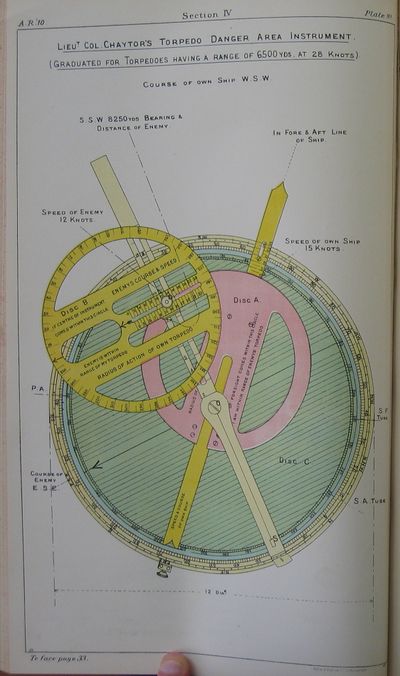Difference between revisions of "Chaytor's Torpedo Danger Area Instrument"
| Line 1: | Line 1: | ||
| − | [[File:ARTS1910Plate10.jpg|thumb|400px|''' | + | [[File:ARTS1910Plate10.jpg|thumb|400px|'''Chaytor's Instrument, 1910'''{{ARTS1910|Plate 10}}]] |
'''Chaytor's Torpedo Danger Area Instrument''' was a torpedo control device conceived by Lieutenant Colonel Chaytor.{{ARTS1910|p. 33}} | '''Chaytor's Torpedo Danger Area Instrument''' was a torpedo control device conceived by Lieutenant Colonel Chaytor.{{ARTS1910|p. 33}} | ||
| Line 5: | Line 5: | ||
==Function== | ==Function== | ||
| − | + | Its function is described in the ''Annual Report of the Torpedo School, 1910''.{{ARTS1910|pp. 33-4}} | |
| + | Briefly, the device was quite a bit like a [[Dumaresq]], but was likely flatter. It had a pair of round discs of equal diameter whose diameter was proportional to the supposed (equal) range of the friendly and enemy torpedoes. The user set up the following inputs: | ||
# Own speed and course (this arm was fixed along your keel line - you would rotate an outer ring to set your heading) | # Own speed and course (this arm was fixed along your keel line - you would rotate an outer ring to set your heading) | ||
| Line 15: | Line 16: | ||
==Development and Experience== | ==Development and Experience== | ||
| − | It was mentioned in | + | It was first mentioned in ''Annual Report of the Torpedo School, 1909'', along with a reportedly similar device proposed by Naval Instructor Veater. Though both were to receive sea trials,{{ARTS1909|p. 22}} Veater's was apparently dropped without more than cursory testing.{{ARTS1910|p. 34}} |
| − | A single | + | A single Chaytor instrument was tested in {{UK-Dreadnought}} in 1910, but was "adversely reported on, on account of the difficulty of obtaining all the necessary data simultaneously, and the time taken to adjust the instrument." It was hoped that a different sort of design might work around these issues.{{ARTS1910|p. 34}} |
==See Also== | ==See Also== | ||
Revision as of 21:19, 27 November 2012

Chaytor's Torpedo Danger Area Instrument was a torpedo control device conceived by Lieutenant Colonel Chaytor.[2]
The device showed in a graphic manner the moment when your ship and that of an enemy would fall within range of each other's torpedoes. As it showed the geometry graphically, it offered ideas of how to maneuver to speed up or altogether avoid the moment of danger, or to gauge how truly dangerous it was.
Function
Its function is described in the Annual Report of the Torpedo School, 1910.[3] Briefly, the device was quite a bit like a Dumaresq, but was likely flatter. It had a pair of round discs of equal diameter whose diameter was proportional to the supposed (equal) range of the friendly and enemy torpedoes. The user set up the following inputs:
- Own speed and course (this arm was fixed along your keel line - you would rotate an outer ring to set your heading)
- Enemy's speed and course (as in a dumaresq, this assembly was carried on the own speed slider)
- Bearing and distance to enemy
- Range and speed of the torpedoes (both being assumed the same)
If the disc borne on the enemy slider covered the center of the device, the moment when torpedoes capable of reaching their target had arrived.
Development and Experience
It was first mentioned in Annual Report of the Torpedo School, 1909, along with a reportedly similar device proposed by Naval Instructor Veater. Though both were to receive sea trials,[4] Veater's was apparently dropped without more than cursory testing.[5]
A single Chaytor instrument was tested in Dreadnought in 1910, but was "adversely reported on, on account of the difficulty of obtaining all the necessary data simultaneously, and the time taken to adjust the instrument." It was hoped that a different sort of design might work around these issues.[6]
See Also
Footnotes
- ↑ Annual Report of the Torpedo School, 1910. Plate 10.
- ↑ Annual Report of the Torpedo School, 1910. p. 33.
- ↑ Annual Report of the Torpedo School, 1910. pp. 33-4.
- ↑ Annual Report of the Torpedo School, 1909. p. 22.
- ↑ Annual Report of the Torpedo School, 1910. p. 34.
- ↑ Annual Report of the Torpedo School, 1910. p. 34.
Bibliography
- H.M.S. Vernon. Annual Report of the Torpedo School, 1909, with Appendix (Wireless Telegraphy). Copy 7 at The National Archives. ADM 189/29.
- H.M.S. Vernon. Annual Report of the Torpedo School, 1910, with Appendix (Wireless Telegraphy). Copy 436 at The National Archives. ADM 189/30.